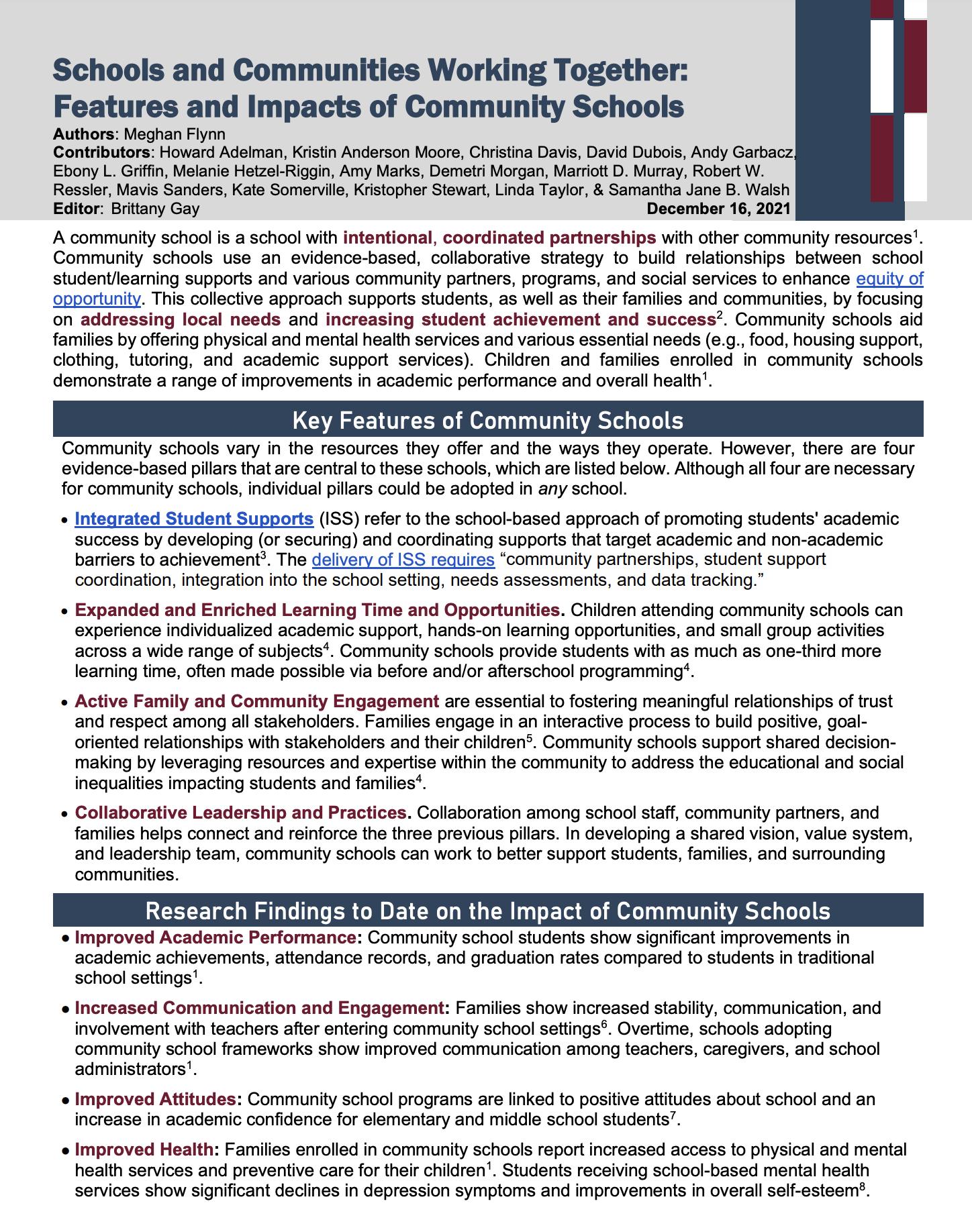
A community school is a school with intentional, coordinated partnerships with other community resources [1]. Community schools use an evidence-based, collaborative strategy to build relationships between school student/learning supports and various community partners, programs, and social services to enhance equity of opportunity. This collective approach supports students, as well as their families and communities, by focusing on addressing local needs and increasing student achievement and success [2]. Community schools aid families by offering physical and mental health services and various essential needs (e.g., food, housing support, clothing, tutoring, and academic support services). Children and families enrolled in community schools demonstrate a range of improvements in academic performance and overall health [1].
Key Features Of Community Schools
Community schools vary in the resources they offer and the ways they operate. However, there are four evidence-based pillars that are central to these schools, which are listed below. Although all four are necessary for community schools, individual pillars could be adopted in any school.
- Integrated Student Supports (ISS) refer to the school-based approach of promoting students’ academic success by developing (or securing) and coordinating supports that target academic and non-academic barriers to achievement [3]. The delivery of ISS requires “community partnerships, student support coordination, integration into the school setting, needs assessments, and data tracking.”
- Expanded and Enriched Learning Time and Opportunities. Children attending community schools can experience individualized academic support, hands-on learning opportunities, and small group activities across a wide range of subjects [4]. Community schools provide students with as much as one-third more learning time, often made possible via before and/or afterchool programming [4].
- Active Family and Community Engagement are essential to fostering meaningful relationships of trust and respect among all stakeholders. Families engage in an interactive process to build positive, goal-oriented relationships with stakeholders and their children5. Community schools support shared decision-making by leveraging resources and expertise within the community to address the educational and social inequalities impacting students and families [4].
- Collaborative Leadership and Practices. Collaboration among school staff, community partners, and families helps connect and reinforce the three previous pillars. In developing a shared vision, value system, and leadership team, community schools can work to better support students, families, and surrounding communities.
Research Findings To Date On The Impact Of Community Schools
- Improved Academic Performance: Community school students show significant improvements in academic achievements, attendance records, and graduation rates compared to students in traditional school settings [1].
- Increased Communication and Engagement: Families show increased stability, communication, and involvement with teachers after entering community school settings [6]. Overtime, schools adopting community school frameworks show improved communication among teachers, caregivers, and school administrators [1].
- Improved Attitudes: Community school programs are linked to positive attitudes about school and an increase in academic confidence for elementary and middle school students [7].
- Improved Health: Families enrolled in community schools report increased access to physical and mental health services and preventive care for their children [1]. Students receiving school-based mental health services show significant declines in depression symptoms and improvements in overall self-esteem [8].
Potential Options For Policy At The State, Federal, And Local Levels
Community schools provide an important catalytic force for transforming how schools address barriers to learning and teaching and re-engage students and families.9 With this in mind, policymakers could:
- Establish or incentivize district and school-level collaborative partnerships and infrastructures for the planning, developing, sustainable implementation, and ongoing renewal of community schools.
- Support schools and communities in integrating programs and services aligned with the four pillars of community schools. Examples could include investments in hiring and training community members and partners, building new infrastructure that incorporates community spaces into the learning environment, and maintaining resources for children and their families (e.g., on-site access to food, supplies, and clothing) [10].
- Provide support for collaborative needs assessments, ongoing evaluation, and scaling efforts. These efforts can identify existing community resources and the needs of students, families, and school staff, which usually involve sharing data among many partners that provide services at community schools. Policymakers can make the process easier by clarifying and aligning regulations on data sharing at the federal and state levels [7].
- Provide capacity building and technical assistance for school and community partners to support the entire process. This includes collaborative mapping of existing school and community resources, the identification of intervention gaps and priorities at different schools, and aligning current efforts to develop them into a unified and comprehensive framework (e.g., building on a school’s multitiered continuum of interventions and organizing them into a coherent set of support domains).
- Further engage policy to ensure that community schools evolve initial partnerships, over time, into a unified, comprehensive, and equitable system for addressing barriers to learning and teaching. Immediate policy support could include improving how schools’ student and learning supports are designed and intertwined with existing community resources.
End Notes / References
- Blank, M. J., Melaville, A., & Shah, B. P. (2003). Making the Difference: Research and Practice in Community Schools. Coalition for Community Schools, Institute for Educational Leadership, 1001 Connecticut Avenue, NW, Suite 310, Washington, DC 20036.
- https://www.nysut.org/resources/all-listing/research/fact-sheets/fact-sheet-community-schools-in-new-york-state
- https://www.communitiesinschools.org/media/filer_public/d4/78/d47825df-b62f-45b8-8d57-31d8ab8b7294/iss_state_policy_toolkit_06242019.pdf
- https://communityschools.futureforlearning.org/assets/downloads/community-schools-playbook.pdf
- https://eclkc.ohs.acf.hhs.gov/school-readiness/article/head-start-parent-family-community-engagement-framework
- Catania, K. J. H. (2005). A comparative study of after school programs in Fresno County: Search for factors related to high effectiveness (Doctoral dissertation, Alliant International University, Fresno).
- Castrechini, S., & London, R. A. (2012). Positive Student Outcomes in Community Schools. Center for American Progress.
- Weist, M. D., Paskewitz, D. A., Warner, B. S., & Flaherty, L. T. (1996). Treatment outcome of school-based mental health services for urban teenagers. Community mental health journal, 32(2), 149-157. https://doi.org/10.1007/BF02249752
- Center for MH in Schools & Student Learning Supports (2021). Evolving Community Schools and Transforming Student/Learning Supports. Los Angeles: Author at UCLA. http://smhp.psych.ucla.edu/pdfdocs/evolvecomm.pdf
- https://learningpolicyinstitute.org/product/federal-funds-cs-factsheet
The Research-to-Policy Collaboration (RPC) works to bring together research professionals and public officials to support evidence-based policy. Please visit their website to learn more.
Key Information
RPC Website
Research-to-Policy Collaboration
Publication DateDecember 16, 2021
Topic Area(s)Community-Specific, Education and Child Development, Equity
Resource TypeWritten Briefs
Share This Page
A community school is a school with intentional, coordinated partnerships with other community resources [1]. Community schools use an evidence-based, collaborative strategy to build relationships between school student/learning supports and various community partners, programs, and social services to enhance equity of opportunity. This collective approach supports students, as well as their families and communities, by focusing on addressing local needs and increasing student achievement and success [2]. Community schools aid families by offering physical and mental health services and various essential needs (e.g., food, housing support, clothing, tutoring, and academic support services). Children and families enrolled in community schools demonstrate a range of improvements in academic performance and overall health [1].
Key Features Of Community Schools
Community schools vary in the resources they offer and the ways they operate. However, there are four evidence-based pillars that are central to these schools, which are listed below. Although all four are necessary for community schools, individual pillars could be adopted in any school.
- Integrated Student Supports (ISS) refer to the school-based approach of promoting students’ academic success by developing (or securing) and coordinating supports that target academic and non-academic barriers to achievement [3]. The delivery of ISS requires “community partnerships, student support coordination, integration into the school setting, needs assessments, and data tracking.”
- Expanded and Enriched Learning Time and Opportunities. Children attending community schools can experience individualized academic support, hands-on learning opportunities, and small group activities across a wide range of subjects [4]. Community schools provide students with as much as one-third more learning time, often made possible via before and/or afterchool programming [4].
- Active Family and Community Engagement are essential to fostering meaningful relationships of trust and respect among all stakeholders. Families engage in an interactive process to build positive, goal-oriented relationships with stakeholders and their children5. Community schools support shared decision-making by leveraging resources and expertise within the community to address the educational and social inequalities impacting students and families [4].
- Collaborative Leadership and Practices. Collaboration among school staff, community partners, and families helps connect and reinforce the three previous pillars. In developing a shared vision, value system, and leadership team, community schools can work to better support students, families, and surrounding communities.
Research Findings To Date On The Impact Of Community Schools
- Improved Academic Performance: Community school students show significant improvements in academic achievements, attendance records, and graduation rates compared to students in traditional school settings [1].
- Increased Communication and Engagement: Families show increased stability, communication, and involvement with teachers after entering community school settings [6]. Overtime, schools adopting community school frameworks show improved communication among teachers, caregivers, and school administrators [1].
- Improved Attitudes: Community school programs are linked to positive attitudes about school and an increase in academic confidence for elementary and middle school students [7].
- Improved Health: Families enrolled in community schools report increased access to physical and mental health services and preventive care for their children [1]. Students receiving school-based mental health services show significant declines in depression symptoms and improvements in overall self-esteem [8].
Potential Options For Policy At The State, Federal, And Local Levels
Community schools provide an important catalytic force for transforming how schools address barriers to learning and teaching and re-engage students and families.9 With this in mind, policymakers could:
- Establish or incentivize district and school-level collaborative partnerships and infrastructures for the planning, developing, sustainable implementation, and ongoing renewal of community schools.
- Support schools and communities in integrating programs and services aligned with the four pillars of community schools. Examples could include investments in hiring and training community members and partners, building new infrastructure that incorporates community spaces into the learning environment, and maintaining resources for children and their families (e.g., on-site access to food, supplies, and clothing) [10].
- Provide support for collaborative needs assessments, ongoing evaluation, and scaling efforts. These efforts can identify existing community resources and the needs of students, families, and school staff, which usually involve sharing data among many partners that provide services at community schools. Policymakers can make the process easier by clarifying and aligning regulations on data sharing at the federal and state levels [7].
- Provide capacity building and technical assistance for school and community partners to support the entire process. This includes collaborative mapping of existing school and community resources, the identification of intervention gaps and priorities at different schools, and aligning current efforts to develop them into a unified and comprehensive framework (e.g., building on a school’s multitiered continuum of interventions and organizing them into a coherent set of support domains).
- Further engage policy to ensure that community schools evolve initial partnerships, over time, into a unified, comprehensive, and equitable system for addressing barriers to learning and teaching. Immediate policy support could include improving how schools’ student and learning supports are designed and intertwined with existing community resources.
End Notes / References
- Blank, M. J., Melaville, A., & Shah, B. P. (2003). Making the Difference: Research and Practice in Community Schools. Coalition for Community Schools, Institute for Educational Leadership, 1001 Connecticut Avenue, NW, Suite 310, Washington, DC 20036.
- https://www.nysut.org/resources/all-listing/research/fact-sheets/fact-sheet-community-schools-in-new-york-state
- https://www.communitiesinschools.org/media/filer_public/d4/78/d47825df-b62f-45b8-8d57-31d8ab8b7294/iss_state_policy_toolkit_06242019.pdf
- https://communityschools.futureforlearning.org/assets/downloads/community-schools-playbook.pdf
- https://eclkc.ohs.acf.hhs.gov/school-readiness/article/head-start-parent-family-community-engagement-framework
- Catania, K. J. H. (2005). A comparative study of after school programs in Fresno County: Search for factors related to high effectiveness (Doctoral dissertation, Alliant International University, Fresno).
- Castrechini, S., & London, R. A. (2012). Positive Student Outcomes in Community Schools. Center for American Progress.
- Weist, M. D., Paskewitz, D. A., Warner, B. S., & Flaherty, L. T. (1996). Treatment outcome of school-based mental health services for urban teenagers. Community mental health journal, 32(2), 149-157. https://doi.org/10.1007/BF02249752
- Center for MH in Schools & Student Learning Supports (2021). Evolving Community Schools and Transforming Student/Learning Supports. Los Angeles: Author at UCLA. http://smhp.psych.ucla.edu/pdfdocs/evolvecomm.pdf
- https://learningpolicyinstitute.org/product/federal-funds-cs-factsheet
The Research-to-Policy Collaboration (RPC) works to bring together research professionals and public officials to support evidence-based policy. Please visit their website to learn more.

Key Information
RPC Website
Research-to-Policy Collaboration
Publication DateDecember 16, 2021
Topic Area(s)Community-Specific, Education and Child Development, Equity
Resource TypeWritten Briefs
Share This Page
LET’S STAY IN TOUCH
Join the Evidence-to-Impact Mailing List
Keep up to date with the latest resources, events, and news from the EIC.




